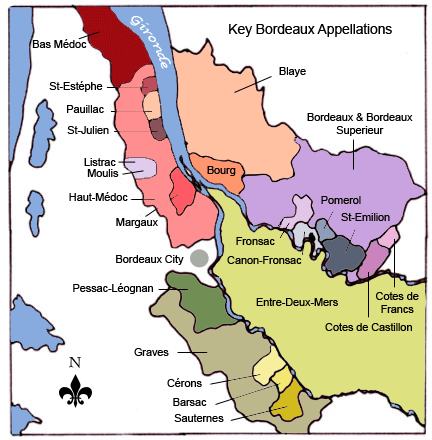Bordeaux. Its name alone is imposing and augurs quality wines. Mythical names, mythical areas, mythical varieties, even its prices are mythical. Because Bordeaux itself, as a wine-growing area, is a myth. Petrus, Chateau D’Yquem, Mouton Rothschild, Latour… Names that are the elite of the wine world. But, fortunately, not everything in Bordeaux are charismatic wines, otherwise most of us mortals would not be able to drink their bottles. Nor does its name ensure excellence. Nor are all the wines red, as the whites also have their place and the sweet wines are excellent.
An irrefutable fact is the importance of the producer, to the point that the “crus” system is organised according to the quality of the cellars and not of the vineyards or villages, as is the case in Burgundy and Champagne, respectively. But to understand the Bordeaux wine region, we must start with its basic characteristics, and then I will develop the different zones, their specialities and their main producers.
I particularly like to divide the Bordeaux wine region into four parts: the left bank of the Garonne river, the right bank (Dordogne tributary), the centre, Entre Deux Mares (between the two branches of the Garonne river), and the south, Sauternes and Barsac.
On the left bank, north of the city of Bordeaux, is the Médoc, which is a coastal strip no more than ten kilometres wide on the left bank of the mouth of the Garonne. Its soils are predominantly gravel and Cabernet Sauvignon is the dominant variety. In turn, it is mainly divided into the following appellations: Margaux, Saint-Julien, Pauillac and Saint-Estèphe.
Also on the left bank, but south of Bordeaux, is Pessac-Leognan, where reds predominate, although great whites are also produced. Here, the main varieties used are Cabernet Sauvignon and Merlot, in a blend of similar proportions.
On the right bank, we find Libournais, which, in turn, has several appellations: Fronsac, Canon Fronsac, Pomerol, Lalande de Pomeros, Saint Emilion and Côtes de Castillon. Unlike the soils of the Médoc, clay and sandy soils predominate. The main grape variety is Merlot, although many of their wines also contain a small percentage of Cabernet Franc.
Entre Dos Mares, despite its size, is the most unknown area because it has not acquired the importance of the rest. The appellations are: Graves de Vayres, Premières Côtes de Bordeaux, Cadillac, Loupiac, Sainte-Croix-du-Mont, Haut-Benauge, Côtes de Bordeaux-Saint-Macaire, Sainte-Foy-Bordeaux.
In the south, where the sweet wines of Sauternes and Barsac reign supreme, Sauvignon Blanc and Semillon, in particular, are the grape varieties that produce exquisite wines thanks to botrytis cinerea (noble rot).
The Bordeaux wine region is a delight for the wine lover, but it is also a delight for the traveller who wants to see charming villages scattered among a landscape of small châteaux emerging from the vineyards. There are many reasons why Bordeaux is a mythical and indispensable area.
